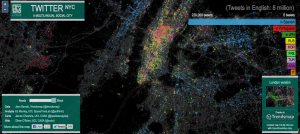This might just be me taking any excuse I can find to talk about an author I like, but the writings of Stanislaw Lem do seem relevant to DH work. Specifically, “How The World Was Saved” applies well to the principles of something like text analysis or topic modeling.
In the story, Trurl (a robotic engineer/constructor) builds a machine that could create anything starting with the letter N. Already this enacts a constraint, from which Trurl can create and build. Trurl must learn to work within this limit (and it is quickly established that there are no shortcuts to get outside of the machine’s programming). The difference, of course, is that what this machine creates also exists in the real world. In other word, by limiting its contents (or data) to a finite number, the programming of the machine enacts a “deformance” on the universe, as if it were a text.
We can also relate Trurl’s machine to the theory vs methodology debate. Trurl doesn’t approach the machine with a specific question he needs answering or an end result he would like to achieve. Instead, Trurl experiments, feeding the machine words and testing the limits of its programming. To relate this to Fish, Trurl does not begin with an interpretive hypothesis that needs answering, as is typical in the humanities. Likewise, he doesn’t apply this hypothesis to the machine’s results and look for a formal pattern. In DH, the direction is reversed (witnessing a formal pattern and then formulating an interpretive hypothesis). Trurl takes the DH approach.
Unfortunately for Trurl, the word he uses to reach this point, “Nothing,” nearly destroys the universe. But what is interesting is how the machine responds to Trurl’s command:
Had I made Nothing outright, in one fell swoop, everything would have ceased to exist, and that includes Trurl, the sky, the Universe, and you – and even myself. In which case who could say and to whom could it be said that the order was carried out and I am an efficient and capable machine?
Trurl’s experiment with “Nothing,” which unfortunately eliminates all of those “worches” and “zits,” can be considered the outlier in the machine’s results. It represents a moment in which, in order to follow both its programming and its command, the machine must alter its methodology somewhat (not to mention the universe itself). This might be the type of result we look for when running topic models or text analyses: the ones that confront what the tools struggles or fails to do or even strains itself doing.
Of course, Trurl’s machine is just science-fiction and doesn’t technically exist, but I wouldn’t mind experimenting with it myself.
(Side Note: Another of Lem’s stories, “Trurl’s Electronic Bard,” could have easily been the subject of another blog post, applying particularly well to our discussion in the first few weeks. But don’t worry, I’ll spare you the long-winded essay . . . for now.)









